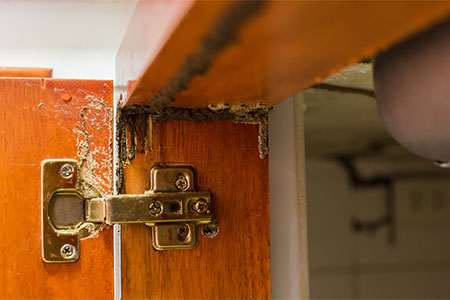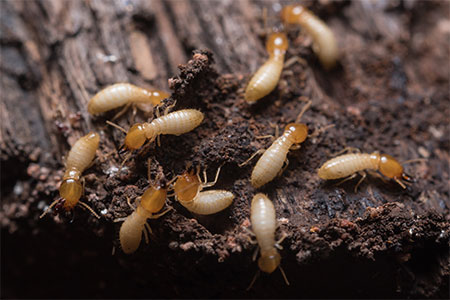Use Our Pest Control Services to Get Rid of Termites
Termites are among the most destructive pests that can invade residential and commercial properties, causing billions of dollars in damage each year. These silent invaders often go unnoticed until significant harm has been done, making early identification and effective treatment crucial. Arizona homes are primarily threatened by subterranean termites, but other species like dampwood and drywood termites also pose serious risks. Each type of termite behaves differently, infests different environments, and requires a unique approach to detection and removal. But with termite control services by our experienced team at Anteater Exterminating, we’ll handle all of that for you.


Types of Termites
Subterranean termites have a primary king and queen; they also have supplemental kings and queens. The king and queen are in a primary colony, while the supplemental kings and queens are in supplemental colonies. The primary and supplemental colonies are networked together. They are typically a few feet wide and can be up to a few stories deep in the soil. This is how this genus of termites gets its name.
Other Species of Pesky Termites:
Dampwood Termites
Dampwood termites thrive in wet and dead trees and are typically found in areas with high humidity. This species are less common in Arizona but still pose a threat to wooden structures.
Drywood Termites
Unlike a subterranean termite, drywood termites infest dry, undecayed wood and do not require contact with soil. They often build their colonies within wooden structures, making them challenging to detect.
The Heterotermites are a neighborhood problem. They tend to feed on multiple food supply sources: your house, the neighbor’s house, dead tree roots, woodpiles, whatever source they can find. Subterranean termites consume the wood components that make up your house. The termites take the wood back down into their colony, they feed the reproductives, they feed the larva, and they interact socially.
Schedule Regular Inspections for Termite Prevention
Termites live in cryptobiotic life, which is a hidden life. Whenever there are visible signs of termite activity, the assumption can be made that there are many more active infestations that you cannot see. This hidden lifestyle allows termites to enter structures and do extensive damage without you ever knowing. The harm that they do can be significant. It is a fact that termites cause more annual damage than fires, storms, tornadoes, and hurricanes combined.
Termites can enter a home through cracks that exist around the foundation or in the flooring and around conduit that penetrates the slab. Once you have evidence or visible signs of termites, it is evidence that we call “presumptive of an underlying infestation.”
The only definitive way to conclude that there is an infestation present in your home or office building is by contacting Anteater Exterminating and scheduling a thorough inspection and determine the best approach to your pest problem.
Long-Lasting Termite Removal
The treatment of subterranean termites should always be done by a professional. The structure should be inspected, a detailed diagrammatic description should be made, and then a treatment plan can be properly prescribed.
The most effective treatment in the Phoenix metro area is to do a conventional treatment. Anteater Exterminating uses Termidor SC® predominantly. This product is by far the most effective when treating for subterranean termites. If you are having your structure treated, you should consider using Termidor SC®.
Customized Treatment Plans for Removing Termites
Treatment may involve raking back your landscaped material and digging a small trench along the foundation of your home and then filling the trench full of Termidor SC® at 4 gallons per 10 linear feet. As the soil is put back into the trench, it must be mixed into the Termidor SC®. The landscaping can then be graded to its original placement. We may have to drill through cement porch slabs and inject the material underneath the slab to obtain 4 gallons per 10 linear feet. The drill holes are patched after treatment. It may also be necessary to drill through the garage slab and use the same process as on the concrete porch slabs.
Depending on the type of construction your home is, there may be a variety of pest treatments that would need to be performed. For this reason, it is essential to have a visual termite inspection to determine the type of construction, the extent of the infestation, and plan the correct method of treatment.
There have been newer products that have been introduced to the market that have given us other tools in our toolbox that we can use to combat subterranean termites. One of these materials is known as Termidor Dry®, and it has the advantage of the Termidor Transfer Effect®. It can be applied directly to termite areas of activity inside of different wood components that comprise your home.
Other Pest Control Services We Offer:
- Rodent Control
- Cockroach Control
- Bed Bug Infestations
- Scorpion Control
- Wasp and Bee Control
- Spider Control
- Ant Control
- And More Exterminator Services


Looking for Reliable Termite Control Near Me?
At Anteater Exterminating, we offer a 5-year guarantee with some of our termite treatments. This guarantee is comprehensive and will offer you the highest degree of protection in the event that further termite problems.
Termites won’t wait, and neither should you. With their ability to cause massive, hidden damage to your home or business, early action is key. At Anteater Exterminating, our expert team is trained to detect, treat, and prevent all types of termite infestations using industry-leading solutions. Don’t let these silent destroyers compromise the safety and value of your property. Call us today to schedule your comprehensive termite inspection and take the first step toward total termite control in Glendale, AZ.
1. Chemical Barrier Treatments: This involves applying liquid termiticides around the perimeter of your home or building. The goal is to create a barrier that termites cannot cross, effectively protecting the structure.
2. Baiting Systems: Termite baits are strategically placed around the property. Termites consume the bait and share it with the colony, eventually leading to its elimination. Baiting systems are less invasive and can be effective for long-term control.
3. Wood Treatments: For drywood termites, treating infested wood directly with termiticides or heat can eliminate colonies. This method is targeted and effective for localized infestations.
4. Fumigation: This is a highly effective method for severe infestations or widespread termite problems. It involves enclosing the structure and introducing a fumigant that penetrates all areas, killing termites throughout.
5. Integrated Pest Management (IPM): Combining several methods, including monitoring, habitat modification, and chemical treatments, to manage and prevent termite infestations.
Knowledge and Expertise: Pest control professionals are trained to identify termite species, assess the extent of the infestation, and apply appropriate treatments.
Equipment and Tools: Effective termite treatments often require specialized equipment and tools that professionals have access to.
Safety and Regulations: Handling termiticides and fumigants can be hazardous. Pest control professionals are trained in safety protocols and adhere to regulations for proper application.
Guaranteed Results: Professional pest control services typically come with warranties or guarantees, ensuring that if termites return within a certain period, they will retreat at no additional cost.
While DIY products may offer temporary relief, a termite infestation requires thorough and effective treatment to prevent damage to your home. Professional pest control services provide comprehensive solutions and peace of mind.
Structural Damage: Termites feed on wood, including support beams and other structural components. Over time, this can weaken the integrity of your home and lead to costly repairs.
Hidden Infestations: Termites can be difficult to detect because they often reside inside walls, floors, and other hidden areas. By the time you notice visible signs, such as mud tubes or damaged wood, the infestation may be extensive.
Financial Impact: Repairing termite damage can be expensive. Most homeowner’s insurance policies do not cover termite damage, so prevention and early detection are crucial.
Health Risks: While termites do not pose direct health risks to humans, the presence of termites and their byproducts can exacerbate allergies and respiratory issues in some individuals.
Given these factors, it’s advisable to schedule regular termite inspections and take preventive measures to protect your home from termites. Prompt action at the first sign of termites can help minimize damage and avoid costly repairs in the future.
